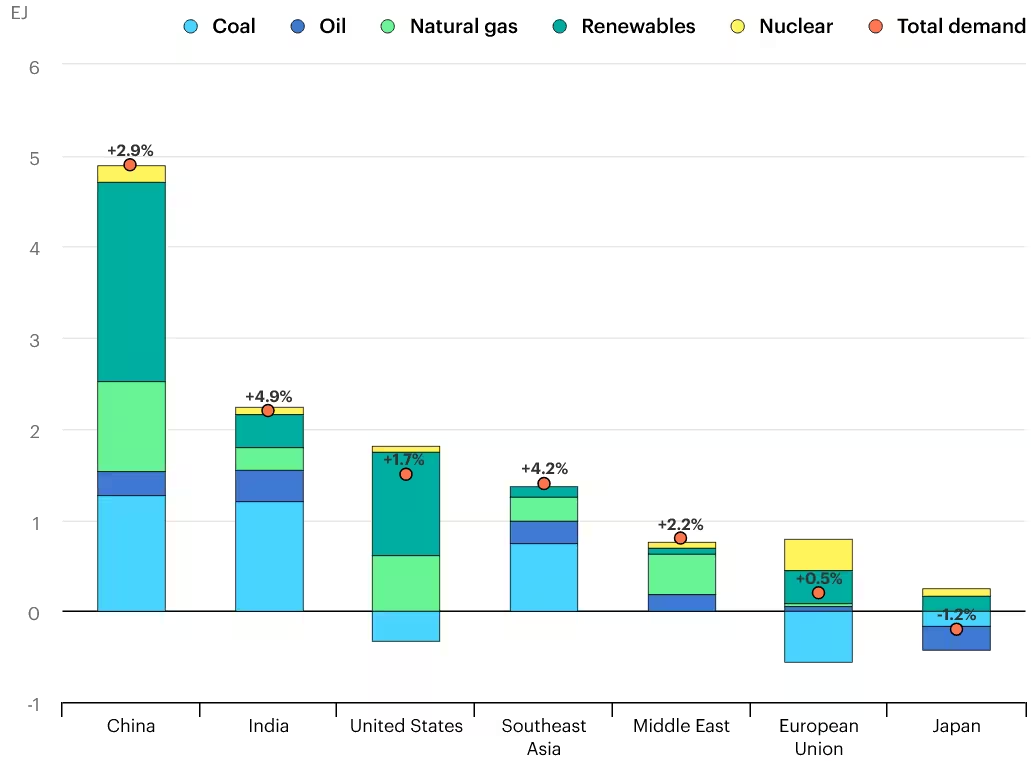IEA: Global energy demand accelerates, carbon emissions reach new record in 2024
24 March 2025
Global energy demand grew at a faster-than-average pace in 2024 as the consumption of electricity rose around the world—with increased supply of renewables and natural gas covering the majority of additional energy needs, according to the International Energy Agency’s (IEA) Global Energy Review report.
Global energy demand rose by 2.2% last year—considerably faster than the average annual demand increase of 1.3% between 2013 and 2023. Emerging and developing economies accounted for over 80% of the increase in global energy demand in 2024. This was despite slower growth in China, where energy consumption rose by less than 3%, half its 2023 rate and well below the country’s recent annual average. On the other hand, after several years of declines, advanced economies saw a return to growth, with their energy demand increasing by almost 1% in aggregate.

(Source: IEA)
Power Generation. The acceleration in global energy demand growth in 2024 was led by the power sector, with global electricity consumption surging by nearly 1,100 TWh, or 4.3%. This was nearly double the annual average over the past decade. The sharp increase in the world’s electricity use last year was driven by rising demand for cooling in many countries, rising consumption from industry, the electrification of transport, and the growth of data centers and artificial intelligence.
The amount of new renewable power capacity installed worldwide rose to around 700 GW, setting a new annual record for the 22nd consecutive year. Nuclear power capacity additions exceeded 7 GW, reaching the fifth highest level in the past three decade. Nuclear construction starts increased 50% in 2024, exclusively using Chinese and Russian nuclear technology.
New non-fossil generation (renewables and nuclear) provided 80% of the increase in global electricity demand in 2024. The supply of natural gas-fired generation also increased steadily to cover rising electricity demand. This means that the growth of renewable capacity was still insufficient to replace any fossil generation, and renewables continued to be added on top of rising fossil fuels consumption.
The IEA report shows that coal remained the largest source of electricity generation in the world—in 2024, it accounted for 35% of total power generation. Natural gas was the second-largest source of electricity, providing over 20% of global electricity. Oil-fired power plants generated just a few percent of the total.
For the first time ever, power generation from renewables and nuclear covered 40% of total global generation in 2024. Renewables collectively accounted for one-third of electricity generation, led by hydropower (14% of total electricity generation), wind (8%), solar PV (7%) and bioenergy and waste (3%). Nuclear power covered 9% of global electricity generation.
Fossil Fuels. The demand for all major fossil fuels increased in 2024.
- Natural gas saw the strongest demand growth among fossil fuels. Demand increased by 2.7%, rising by 115 billion cubic meters (bcm), compared with an average of around 75 bcm annually over the past decade. China had the largest absolute growth in gas demand in 2024 of over 7% (30 bcm), with growth also strong in other emerging and developing economies in Asia. Gas demand expanded by around 2% (20 bcm) in the United States. Consumption grew modestly in the European Union, notably for industrial use.
- Global coal demand rose by 1%. Power generation was the main driver of growth. China and India together represented the large majority of the global demand increase of around 65 million tonnes of coal equivalent (Mtce), with the demand growth largely driven by rising electricity consumption for cooling. China remained the largest coal consumer globally, accounting for a record 58% of global coal use.
- Global oil demand rose by 0.8% in 2024, compared with a 1.9% increase in 2023. However, trends varied between sectors and regions. Oil demand from global road transport fell slightly, driven by declines in China (-1.8%) and advanced economies (-0.3%). Oil demand from aviation and petrochemicals grew.
Carbon Emissions. Energy-related CO2 emissions increased by 0.8% in 2024, reaching an all-time high of 37.8 billion tonnes. This rise contributed to record atmospheric CO2 concentrations of 422.5 ppm, about 3 ppm higher than 2023 and 50% higher than pre-industrial levels. However, the emission growth was less than global economic growth, as the global GDP expanded by more than 3%, noted the IEA.
Most emissions growth in 2024 came from emerging and developing economies outside China. Emissions growth in China slowed in 2024, though per-capita emissions are now 16% higher than in advanced economies and nearly twice the global average. Emissions in advanced economies fell by 1.1% to 10.9 billion tonnes in 2024—a level seen 50 years ago.
Source: International Energy Agency